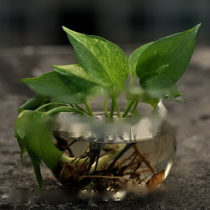
Chinese name: Broad-leaf fig
Latin name: Anubias barteri”broadledf”
Family: Arranaceae
Water temperature: 22- 28℃
Distribution area: West African tropical region
1. Morphology of Ficus broadleaf
The name of Ficus broadleaf is just like its shape, and its leaf width is wider, so it is named. Aquatic plants are monocotyledonous emergent plants and are one of the medium-sized aquatic plants variety. They have stolons and can grow on other objects. The height of the whole plant is about 15 cm to 35 cm. This is quite special in water-soluble genus, the leaves are heart-shaped or peach-shaped, the top is slightly obtuse and acuminate, the base is heart-shaped, the leaf color is emerald green and shiny, with petioles of varying lengths, the surface of the leaves is finely folded, and the edges are smooth. No serrations.
2. Habits of Ficus broadleaf
Ficus broadleaf has strong adaptability, can grow on sunken wood or rocks, and can adapt to a wide range of water quality, but its growth rate is slow , prefers shaded shallow water wetland environment, does not have strict water quality requirements, suitable growth temperature is 22-28 ℃, and the adapted PH value is between 5.5-7.5. There are no strict requirements for light, and aquatic plants can grow well in low-light environments. Generally, the suitable illuminance is 800Lux. The demand for carbon dioxide is not large, but moderate addition during the growth period can promote growth. The requirements for nutrients are not high, and this type of aquatic plant can be used as a mid-background grass in the tank.
3. Cultivation of Ficus broadleaf
The cultivation difficulty of Ficus broadleaf is medium, and aquatic plants can reproduce by new stem and node meristems. Because of its large shape, medium and large water tanks are selected for cultivation. As long as the water quality is non-polluting, it can also be planted on rocks or sunken wood to facilitate landscaping. The lighting requirements are not strict during the growth period, and water plants are in a low-light environment. can also grow. The demand for nutrients is not large, and the water quality is kept clear and balanced. No carbon dioxide is added during the cultivation period, which has little effect on the growth of aquatic plants, but an appropriate amount can also be added to promote the growth rate. The cultivation of aquatic plants is easier and can be used as entry-level aquatic plants.
![[Dog Training 5] The training method of pet dog dining etiquette](/static/img/12192/12192_1.jpg)




